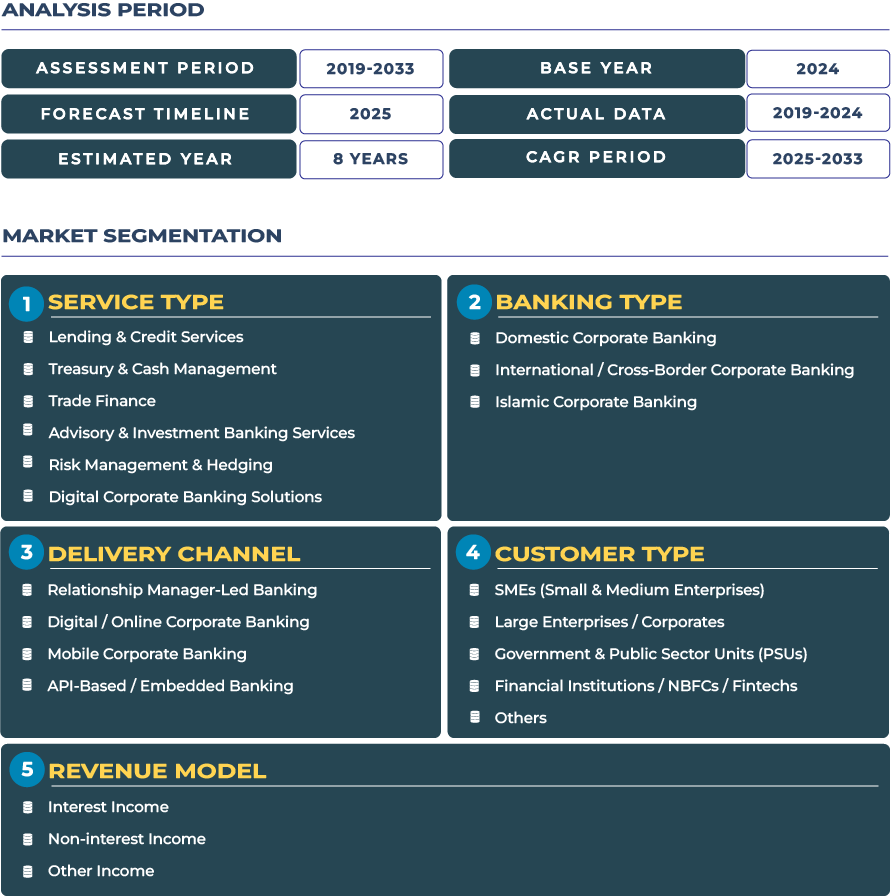Industrial and Export-Oriented Corporate Banking in Germany: Tailored Financing for Manufacturing Giants
Germany corporate banking market stands at the intersection of industry, innovation, and global trade, providing vital capital flows to one of the world’s most export-driven economies. In 2025, the Germany Corporate Banking Market is projected to reach USD 90.3 billion, expected to grow to USD 104.5 billion by 2033, reflecting a modest CAGR of 1.8% from 2025 to 2033. This performance highlights a stable yet strategically evolving corporate banking landscape, one anchored in financing manufacturing, engineering, and export-oriented enterprises. German banks are enhancing Bundesbank-aligned trade financing and industrial loan frameworks to support industrial transformation and supply chain resilience.
Note:* The market size refers to the total revenue generated by banks through interest income, non-interest income, and other ancillary sources.
Germany Corporate Banking Market Outlook: How Corporate Banks Are Powering Germany’s Manufacturing Renaissance
Germany’s industrial ecosystem thrives on precision, export competitiveness, and the ability to finance large-scale manufacturing and trade activities. Corporate banks such as Commerzbank AG and Deutsche Bank are redefining their service portfolios with dedicated export finance, risk hedging, and treasury digitisation products aimed at global supply chain participants. The market’s stability is largely driven by the manufacturing sector’s dependency on structured financing for equipment modernization, cross-border trade, and renewable energy transition initiatives. With global trade recovery and the EU’s green financing commitments, Germany corporate banking industry continues to strengthen its role as a central pillar in the country’s export-led growth model. Moreover, the increasing digitalisation of treasury operations and the integration of real-time liquidity management systems are setting new operational benchmarks for industrial clients.
Drivers & Restraints: Industrial Export Financing and Mittelstand Dynamics Steering Market Momentum
Industrial Exporters Fueling Demand for Tailored Financing and Risk Management
Germany corporate banking growth is powered by its robust manufacturing base and global export competitiveness. Large industrial exporters, from automotive to machinery and chemical sectors, demand customised financial products, including structured export finance and green capital expenditure (CapEx) loans. Corporate banks are strengthening their treasury and cash management solutions to cater to these clients’ cross-border operations. The Federal Ministry for Economic Affairs and Climate Action supports export-led industries with favourable loan guarantees, encouraging banks to expand tailored financing programs. These developments are aligned with the government’s industrial modernisation policies and energy transition objectives, driving consistent lending activity within Germany’s export economy.
Conservative Risk Appetite and Regulatory Complexities Constrain Rapid Innovation
Despite strong fundamentals, several challenges temper the pace of innovation in the Germany corporate banking sector. Banks face a conservative risk appetite, particularly when lending to emerging digital or renewable ventures outside traditional manufacturing. Post-Basel III compliance obligations and export finance regulations have increased operational costs, slowing down product diversification. Additionally, the country’s strong Mittelstand (medium-sized companies) often shows slower fintech adoption due to cultural and operational conservatism. This has limited the uptake of digital corporate banking solutions compared to other European hubs. Rising geopolitical uncertainties, including supply chain disruptions due to global tensions, have also influenced credit risk assessments, causing banks to take more measured approaches to loan disbursement and cross-border liquidity management.
Trends & Opportunities: Industrial Digitalisation, ESG Lending, and Mittelstand Treasury Evolution
Industrie 4.0 and the Rise of Digital Treasury Transformation
A defining trend in Germany corporate banking ecosystem is the digitalisation of industrial finance under the Industrie 4.0 framework. Corporate clients are seeking integrated treasury solutions that automate payments, enhance liquidity forecasting, and link seamlessly with ERP systems. This has accelerated the demand for digital treasury platforms tailored for Mittelstand clients, improving working capital management and transparency. Regional financial centers such as Frankfurt and Munich are witnessing the proliferation of digital cash management hubs, which enable corporates to manage multi-currency transactions efficiently across borders. Banks are also leveraging APIs to offer Banking-as-a-Service (BaaS) models, allowing industrial enterprises to access real-time treasury functions within their existing software environments.
ESG-Linked Financing and Factory Modernisation as Growth Catalysts
The transition to sustainable industrial production is driving new opportunities in ESG-linked corporate lending. German banks are increasingly structuring sustainability-linked loans, with incentives tied to emission reductions, energy efficiency, and supply chain sustainability targets. Programs inspired by KfW Bankengruppe’s initiatives are expanding, particularly for industrial automation and factory modernization. These sustainability-linked loans support clients’ capital expenditure while aligning with Germany’s broader environmental objectives under the EU Green Deal framework. Moreover, supplier financing solutions for the automotive sector and export risk hedging for machinery producers represent key opportunities for banks to deepen industrial relationships.
Competitive Landscape: Strategic Alliances and Digital Evolution Among Leading Banks
Germany corporate banking landscape is dominated by major players like Deutsche Bank, Commerzbank, and DZ Bank, alongside international entrants such as BNP Paribas and HSBC Germany. In 2024, Deutsche Bank expanded its industrial finance portfolio through a “Green Trade Finance” product line targeting export-oriented manufacturing clients. Meanwhile, Commerzbank launched a digital treasury platform for Mittelstand clients, integrating AI-based liquidity forecasting tools in 2024 to streamline industrial cash flow planning. DZ Bank partnered with KfW to support factory modernization loans under sustainable finance frameworks, reflecting growing alignment between commercial and development banking entities. These strategic initiatives demonstrate how banks are aligning risk, digitalization, and sustainability within a cohesive industrial financing strategy.







